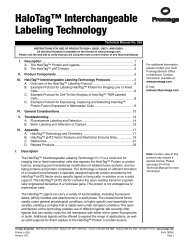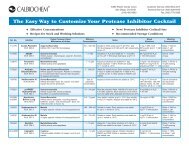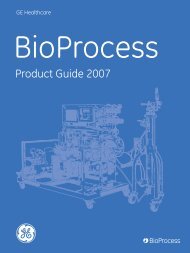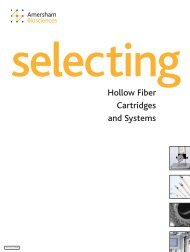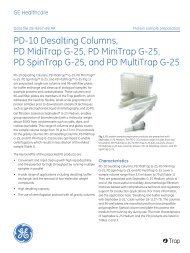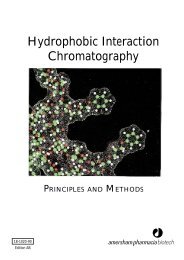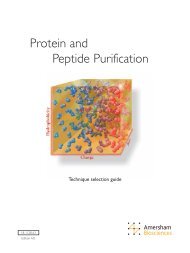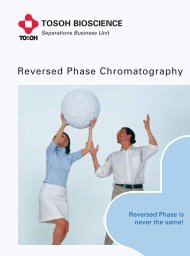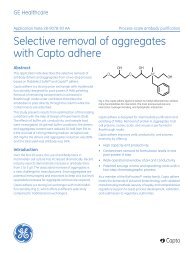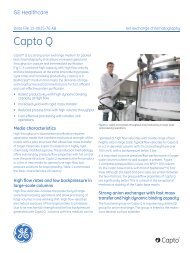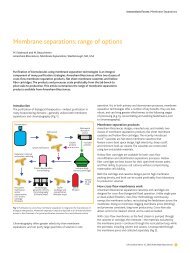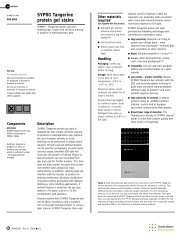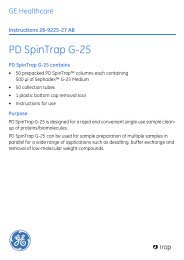HisTrap HP 1 ml and 5 ml
HisTrap HP 1 ml and 5 ml
HisTrap HP 1 ml and 5 ml
You also want an ePaper? Increase the reach of your titles
YUMPU automatically turns print PDFs into web optimized ePapers that Google loves.
instructions<br />
Caution!<br />
Contains nickel.<br />
May produce an<br />
allergic reaction.<br />
i 71-5027-68 Edition AB<br />
<strong>HisTrap</strong> <strong>HP</strong>, 1 <strong>ml</strong> <strong>and</strong> 5 <strong>ml</strong><br />
HiTrap affinity columns<br />
<strong>HisTrap</strong> <strong>HP</strong> is a prepacked, ready-to-use<br />
column for the preparative purification of<br />
His-tagged recombinant proteins by immobilized<br />
metal affinity chromatography (IMAC) using<br />
precharged Ni Sepharose High Performance.<br />
The special design of the column, together<br />
with the high performance matrix, provides<br />
fast, simple <strong>and</strong> easy separations in a<br />
convenient format.<br />
Ni Sepharose High Performance has a low<br />
Ni2+ leakage <strong>and</strong> is compatible with a wide<br />
range of additives used in protein purification.<br />
<strong>HisTrap</strong> <strong>HP</strong> columns can be operated with a<br />
syringe, peristaltic pump or liquid<br />
chromatography system such as ÄKTA design<br />
or FPLC System.
Code No. Designation No. supplied<br />
17-5247-01 <strong>HisTrap</strong> <strong>HP</strong> 1 <strong>ml</strong> 5 x 1 <strong>ml</strong><br />
17-5247-05 <strong>HisTrap</strong> <strong>HP</strong> 1 <strong>ml</strong> 100 x 1 <strong>ml</strong>*<br />
17-5248-01 <strong>HisTrap</strong> <strong>HP</strong> 5 <strong>ml</strong> 1 x 5 <strong>ml</strong><br />
17-5248-02 <strong>HisTrap</strong> <strong>HP</strong> 5 <strong>ml</strong> 5 x 5 <strong>ml</strong><br />
17-5248-05 <strong>HisTrap</strong> <strong>HP</strong> 5 <strong>ml</strong><br />
Connectors<br />
100 x 5 <strong>ml</strong>*<br />
Luerlock female/M6 male 1<br />
Luerlock female/M6 female 1<br />
Tubing connector flangeless/M6 male 1<br />
Tubing connector flangeless/M6 female 1<br />
Union M6 female/1/16" male 1<br />
Union 1/16" female/M6 male 1<br />
Domed nut 2 or 5<br />
Instruction manual 1<br />
* Special pack delivered on specific customer order.<br />
Description<br />
Medium properties<br />
<strong>HisTrap</strong> <strong>HP</strong> 1 <strong>ml</strong> <strong>and</strong> 5 <strong>ml</strong> columns are packed with 1 <strong>ml</strong> <strong>and</strong> 5 <strong>ml</strong><br />
of Ni Sepharose High Performance, respectively. Ni Sepharose<br />
High Performance consists of highly cross-linked agarose beads<br />
to which a chelating group has been immobilized. The metal ion<br />
nickel (Ni2+ ) has then been coupled to the chelating matrix.<br />
Several amino acids, for example histidine, form complexes with<br />
many metal ions. Ni Sepharose High Performance selectively<br />
binds proteins if suitable complex-forming amino acid residues<br />
are exposed on the protein surface. Tagging proteins with<br />
additional histidines, like (His) , increases the affinity for Ni 6 2+<br />
<strong>and</strong> generally makes the His-tagged protein the strongest binder<br />
among other proteins, in e.g., an E. coli extract.<br />
p2
Table 1 summarizes product characteristics.<br />
Table 1. <strong>HisTrap</strong> <strong>HP</strong> characteristics.<br />
Matrix Highly cross-linked spherical agarose, 6%<br />
Mean particle size 34 µm<br />
Metal ion capacity ~15 µmol Ni2+ /<strong>ml</strong> medium<br />
Dynamic binding capacity*<br />
Column volumes<br />
At least 40 mg (His) -tagged protein/<strong>ml</strong> medium<br />
6<br />
1 <strong>ml</strong> or 5 <strong>ml</strong><br />
Column dimensions i.d. × h: 0.7 x 2.5 cm (1 <strong>ml</strong>)<br />
1.6 x 2.5 cm (5 <strong>ml</strong>)<br />
Recommended flow rate 1 <strong>and</strong> 5 <strong>ml</strong>/min for 1 <strong>and</strong> 5 <strong>ml</strong> column respectively<br />
Max. flow rates 4 <strong>and</strong> 20 <strong>ml</strong>/min for 1 <strong>and</strong> 5 <strong>ml</strong> column respectively<br />
Max back pressure** 0.3 MPa, 3 bar<br />
Compatibility during use Stable in all commonly used buffers, reducing agents,<br />
denaturants <strong>and</strong> detergents. See Table 2 for details.<br />
Chemical stability*** 0.01 M HCl, 0.1 M NaOH. Tested for 1 week at 40 ºC.<br />
1 M NaOH, 70% acetic acid. Tested for 12 hours.<br />
2% SDS. Tested for 1 hour.<br />
30% 2-propanol. Tested for 30 min.<br />
Avoid in buffers Chelating agents, e.g. EDTA, EGTA, citrate (see Table 2)<br />
pH stability*** short term (≤ 2 hours): 2-14<br />
long term (≤ 1 week): 3-12<br />
Storage 20% ethanol<br />
Storage temperature +4 to +8 ºC<br />
* Dynamic bindning capacity conditions:<br />
Sample: 1 mg/<strong>ml</strong> (His) -tagged pure protein (M 28 000 or 43 000) in<br />
6 r<br />
binding buffer (Q determination) or (His) -tagged protein<br />
B, 10% 6<br />
bound from E. coli extract<br />
Column volume: 0.25 <strong>ml</strong> or 1 <strong>ml</strong><br />
Flow rate: 0.25 <strong>ml</strong>/min or 1 <strong>ml</strong>/min<br />
Binding buffer: 20 mM sodium phosphate, 0.5 M NaCl, 5 mM imidazole, pH 7.4<br />
Elution buffer: 20 mM sodium phosphate, 0.5 M NaCl, 0.5 M imidazole, pH 7.4<br />
Note: Dynamic binding capacity is protein dependent.<br />
** H O at room temperature<br />
2<br />
*** Ni2+ -stripped medium<br />
The coupling technique used gives both high capacity <strong>and</strong> high<br />
performance. The medium is stable over the pH range 3–12.<br />
p3
The Ni 2+ charged medium tolerates all commonly used aqueous<br />
buffers, reducing agents, denaturants such as 6 M guanidine<br />
hydrochloride <strong>and</strong> 8 M urea, <strong>and</strong> a range of other additives<br />
(see Table 2).<br />
Table 2. Ni Sepharose High Performance is compatible with the following<br />
compounds, at least at the concentrations given.<br />
Reducing agents 5 mM DTE<br />
5 mM DTT<br />
20 mM ß-mercaptoethanol<br />
5 mM TCEP<br />
10 mM reduced glutathione<br />
Denaturing agents 8 M urea*<br />
6 M guanidine hydrochloride*<br />
Detergents 2% Triton X-100 (non-ionic)<br />
2% Tween 20 (non-ionic)<br />
2% NP-40 (non-ionic)<br />
2% cholate (anionic)<br />
1% CHAPS (zwitterionic)<br />
Other additives 500 mM imidazole<br />
20% ethanol<br />
50% glycerol<br />
100 mM Na SO 2 4<br />
0.5–1.5 M NaCl<br />
1 mM EDTA**<br />
60 mM citrate**<br />
Buffer substances 50 mM sodium phosphate, pH 7.4<br />
50 mM Tris-HCl, pH 7.4<br />
100 mM Tris-HCl, pH 7.4<br />
100 mM Tris-acetate, pH 7.4<br />
100 mM HEPES, pH 7.4<br />
100 mM MOPS, pH 7.4<br />
100 mM sodium acetate, pH 4<br />
* Tested for 1 week at +40 °C.<br />
** The strong chelator EDTA has been used successfully in some cases, at 1 mM.<br />
Generally, chelating agents should be used with caution (<strong>and</strong> only in the sample, not the<br />
buffer). Any metal ion stripping may be counteracted by addition of an excess of MgCl . 2<br />
Note that stripping effects may vary with applied sample volume.<br />
p4
Column properties<br />
<strong>HisTrap</strong> <strong>HP</strong> columns are made of biocompatible polypropylene<br />
that does not interact with biomolecules. Columns are delivered<br />
with a stopper on the inlet <strong>and</strong> a twist-off end on the outlet. The<br />
columns have porous top <strong>and</strong> bottom frits that allow high flow<br />
rates. They cannot be opened or refilled.<br />
Columns can be operated with either a syringe <strong>and</strong> the supplied<br />
luer adaptor, a peristaltic pump, or a chromatography system<br />
such as ÄKTAdesign or FPLC System.<br />
Note: To prevent leakage, ensure that the adaptor is tight.<br />
General considerations<br />
<strong>HisTrap</strong> <strong>HP</strong> is supplied precharged with Ni 2+ ions. In general,<br />
Ni 2+ is the preferred metal ion for purification of recombinant<br />
His-tagged proteins. Note, however, that it may be wise to test<br />
other metal ions, e.g. Zn 2+ <strong>and</strong> Co 2+ , as the strength of binding<br />
depends on the nature of the His-tagged protein as well as the<br />
metal ion (see Optimization, page 13).<br />
Choosing binding buffer also depends on the properties of the<br />
chelated metal ion <strong>and</strong> the binding properties of the sample<br />
molecules. We recommend binding at neutral to slightly alkaline<br />
pH (pH 7–8) in the presence of 0.5–1.0 M NaCl. Sodium phosphate<br />
buffers are often used. Tris-HCl can generally be used, but<br />
should be avoided in cases where the metal-protein affinity is<br />
very weak, since it may reduce binding strength. Avoid chelating<br />
agents such as EDTA or citrate in buffers, see Table 2.<br />
Including salt, e.g. 0.5–1.0 M NaCl, in the buffers <strong>and</strong> samples<br />
eliminates any ion exchange effects. It can also have a marginal<br />
effect on the retention of proteins.<br />
p5
Imidazole is commonly used for elution <strong>and</strong>, at lower concentrations,<br />
to increase the selectivity for His-tagged proteins in IMAC. The<br />
binding of non-tagged host cell proteins is discouraged with<br />
imidazole, but a too high concentration of imidazole will also<br />
prevent binding of His-tagged proteins. The concentration of<br />
imidazole that will give optimal purification results (in terms of<br />
purity <strong>and</strong> yield) is protein-dependent, <strong>and</strong> is usually slightly<br />
higher for Ni Sepharose High Performance than for similar IMAC<br />
media on the market. We recommend a highly pure imidazole.<br />
Such imidazole gives essentially no absorbance at 280 nm.<br />
Bound proteins can also be eluted from the medium by several<br />
other methods or combinations of methods. A lowering of pH<br />
within the range of 2.5–7.5 can be used, for example. At pH<br />
values below 4, metal ions will start to be stripped off the<br />
medium.<br />
Note: If the proteins are sensitive to low pH, we recommend<br />
collecting the eluted fractions in tubes containing 1 M<br />
Tris-HCl, pH 9.0 (60–200 µl/<strong>ml</strong> fraction) to restore the<br />
pH to neutral.<br />
Chelating agents such as EGTA or EDTA will also strip the metal<br />
ions from the medium <strong>and</strong> thereby cause protein elution, but the<br />
target protein pool will then contain Ni 2+ ions. In this case, the<br />
Ni 2+ ions can be removed by desalting on a HiTrap Desalting, a<br />
PD-10, or a HiPrep 26/10 Desalting column.<br />
Leakage of Ni 2+ from Ni Sepharose High Performance is very<br />
low under all normal conditions, lower than for other IMAC<br />
media tested. For applications where extremely low leakage<br />
during purification is critical, leakage can be even further<br />
reduced by performing a blank run (see page 11). Likewise, a<br />
p6
lank run should also be performed before applying buffers/<br />
samples with reducing agents (see page 11).<br />
Whatever conditions are chosen, <strong>HisTrap</strong> <strong>HP</strong> columns can be<br />
operated with a syringe, peristaltic pump or a chromatography system.<br />
Note: If a P-1 pump is used, the maximum flow rate that can<br />
be run on a <strong>HisTrap</strong> <strong>HP</strong> 1 <strong>ml</strong> column is 1–3 <strong>ml</strong>/min.<br />
Operation<br />
Buffer preparation<br />
Water <strong>and</strong> chemicals used for buffer preparation should be of<br />
high purity. Filter buffers through a 0.22 µm or a 0.45 µm filter<br />
before use.<br />
We recommend the following binding <strong>and</strong> elution buffers. If the<br />
recombinant His-tagged proteins are expressed as inclusion bodies,<br />
include 6 M guanidine hydrochloride or 8 M urea in all buffers<br />
<strong>and</strong> sample. On-column refolding of the denatured protein may<br />
be possible.<br />
Use a high purity imidazole as this will give very low or no<br />
absorbance at 280 nm.<br />
Recommended starting conditions<br />
Binding buffer: 20 mM sodium phosphate, 0.5 M NaCl,<br />
20–40 mM imidazole, pH 7.4<br />
(The imidazole concentration is protein<br />
dependent)<br />
Elution buffer: 20 mM sodium phosphate, 0.5 M NaCl,<br />
500 mM imidazole, pH 7.4<br />
p7
Sample preparation<br />
For optimal growth, induction <strong>and</strong> cell lysis conditions for your<br />
recombinant His-tagged clones, please refer to recommended protocols.<br />
Adjust the sample to the composition of the binding buffer by<br />
adding buffer, salt <strong>and</strong> additives from concentrated stock<br />
solutions, by diluting it with binding buffer or by buffer<br />
exchange using HiTrap Desalting, a PD-10 column, or HiPrep<br />
26/10 Desalting (see Table 4). Filter the sample through a 0.22<br />
µm or a 0.45 µm filter <strong>and</strong>/or centrifuge it immediately before<br />
applying it to the column. To prevent the binding of cellular host<br />
proteins with exposed histidine, it is essential to include<br />
imidazole at a low concentration in sample <strong>and</strong> binding buffer<br />
(see Optimization).<br />
Table 4. Prepacked columns for desalting <strong>and</strong> buffer exchange.<br />
Code No. Column Load Elute Comments Notes<br />
17-0851-01 PD-10 2.5 <strong>ml</strong> 3.5 <strong>ml</strong> Prepacked with For desalting <strong>and</strong> buffer<br />
Sephadex G-25. exchange of protein<br />
Requires only<br />
gravity to run.<br />
extracts (M >5000).<br />
r<br />
17-1408-01 HiTrap 0.1– 1.3– Prepacked with For desalting <strong>and</strong> buffer<br />
Desalting 1.5 <strong>ml</strong> 4.0 x Sephadex G-25 exchange of protein<br />
applied<br />
volume<br />
Superfine.<br />
Requires a<br />
syringe or<br />
pump to run.<br />
extracts (M >5000).<br />
r<br />
17-5087-01 HiPrep Up to 15– Prepacked with For desalting <strong>and</strong> buffer<br />
26/10 15 <strong>ml</strong> 20 <strong>ml</strong> Sephadex G-25 exchange of protein<br />
Desalting Fine. Requires a extracts (M r >5000).<br />
pump to run.<br />
p8
17-0855-01 NICK 0.1 <strong>ml</strong> 0.4 <strong>ml</strong> Prepacked with For separation of<br />
Sephadex G-25.<br />
Requires only<br />
proteins (M >5000)<br />
r<br />
<strong>and</strong> nick-translated<br />
gravity to run. DNA from radiolabelled<br />
nucleotides<br />
not shorter than<br />
120 mers, <strong>and</strong><br />
similar separations.<br />
17-0853-01 NAP-5 0.5 <strong>ml</strong> 1.0 <strong>ml</strong> Prepacked with For purification of<br />
17-0854-01<br />
17-0852-01<br />
NAP-10<br />
NAP-25<br />
1.0 <strong>ml</strong><br />
2.5 <strong>ml</strong><br />
1.5 <strong>ml</strong><br />
3.5 <strong>ml</strong><br />
Sephadex G-25<br />
DNA grade.<br />
proteins (M >5000),<br />
r<br />
DNA <strong>and</strong> oligonucleo-<br />
Require only tides greater than<br />
gravity to run. 10 bases in length.<br />
Purification<br />
1. Fill the syringe or pump tubing with distilled water. Remove the<br />
stopper <strong>and</strong> connect the column to the syringe (use the adaptor<br />
provided), laboratory pump or chromatography system tubing<br />
”drop-to-drop” to avoid introducing air into the system.<br />
2. Remove the twist-off end.<br />
3. Wash the column with 3–5 column volumes of distilled water.<br />
4. Equilibrate the column with at least 5 column volumes of<br />
binding buffer. Recommended flow rates are 1 <strong>ml</strong>/min or 5<br />
<strong>ml</strong>/min for the 1 <strong>and</strong> 5 <strong>ml</strong> columns respectively.<br />
5. Apply the pretreated sample using a syringe or a pump.<br />
6. Wash with binding buffer until the absorbance reaches a<br />
steady baseline.<br />
Note: The purity of recombinant His-tagged proteins can often<br />
be increased by washing with binding buffer containing as<br />
high concentration of imidazole as possible. However,<br />
care must be taken not to use a concentration of imidazole<br />
that causes elution of the His-tagged protein.<br />
p9
The concentration of imidazole that will give optimal<br />
purification results is protein-dependent, <strong>and</strong> is usually<br />
slightly higher for Ni Sepharose High Performance than<br />
for similar IMAC media on the market (see Optimization).<br />
7. Elute with elution buffer using a step or linear gradient.<br />
5 column volumes are usually sufficient if the protein of<br />
interest is eluted by a step gradient. Other volumes (or a<br />
different elution buffer) may be required if the protein binds<br />
strongly to the medium.<br />
A shallow gradient, e.g. a linear gradient over 20 column<br />
volumes or more, may separate proteins with similar binding<br />
strengths.<br />
Note: If imidazole needs to be removed from the protein, use<br />
HiTrap Desalting, a PD-10 column, or HiPrep 26/10<br />
Desalting depending on the sample volume.<br />
Note: Resistance towards reducing agents is high for Ni<br />
Sepharose High Performance. However, it is<br />
recommended to remove any weakly bound Ni<br />
p10<br />
2+ ions by<br />
performing a blank run without reducing agents (as<br />
described on page 11) before applying buffer/sample<br />
including reducing agents. It is also recommended not to<br />
leave <strong>HisTrap</strong> <strong>HP</strong> columns with buffers including<br />
reducing agents when not in use.<br />
Note: Leakage of Ni2+ from Ni Sepharose High Performance is<br />
low under all normal conditions. The leakage is lower<br />
than for other IMAC media tested. For very critical<br />
applications, leakage during purification can be even<br />
further diminished by performing a blank run (as<br />
described on page 11) before loading sample.
Blank run:<br />
Use binding buffer <strong>and</strong> elution buffer without reducing agents.<br />
1. Wash the column with 5 column volumes of distilled water<br />
(to remove the 20% ethanol).<br />
2. Wash with 5 column volumes of binding buffer.<br />
3. Wash with 5 column volumes of elution buffer.<br />
4. Equilibrate with 10 column volumes of binding buffer.<br />
Stripping <strong>and</strong> recharging<br />
Recommended stripping buffer: 20 mM sodium phosphate, 0.5 M<br />
NaCl, 50 mM EDTA, pH 7.4<br />
Strip the column by washing with at least 5–10 column volumes<br />
of stripping buffer. Wash with at least 5–10 column volumes of<br />
binding buffer <strong>and</strong> 5–10 column volumes of distilled water<br />
before re-charging the column.<br />
Re-charge the water-washed column by loading 0.5 <strong>ml</strong> or 2.5 <strong>ml</strong><br />
of 0.1 M NiSO in distilled water on <strong>HisTrap</strong> <strong>HP</strong> 1 <strong>ml</strong> <strong>and</strong> 5 <strong>ml</strong><br />
4<br />
column, respectively. Salts of other metals, chlorides or sulfates,<br />
may also be used (see Optimization). Wash with 5 column<br />
volumes distilled water, <strong>and</strong> 5 column volumes binding buffer<br />
(important to wash with binding buffer for pH adjustment before<br />
storage in 20% ethanol).<br />
Note: The column does not have to be stripped <strong>and</strong> re-charged<br />
between each purification if the same protein is going to<br />
be purified; it is sufficient to strip <strong>and</strong> re-charge it after<br />
5–7 purifications, depending on the cell extract, extract<br />
volume, target protein, etc.<br />
p11
Cleaning-in-place<br />
When an increase in back-pressure is seen, the column can be<br />
cleaned. Before cleaning, strip off the Ni2+ ions by using the<br />
recommended procedure (see page 11).<br />
After cleaning, store in 20% ethanol (wash with 5 column<br />
volumes) or recharge with Ni2+ prior to storage in ethanol.<br />
The Ni2+ -stripped column can be cleaned by the following methods.<br />
• Remove ionically bound proteins by washing the column with<br />
several column volumes of 1.5 M NaCl. Then wash the<br />
column with approx. 10 column volumes of distilled water.<br />
• Remove precipitated proteins, hydrophobically bound<br />
proteins <strong>and</strong> lipoproteins by washing the column with 1 M<br />
NaOH, contact time usually 1–2 hours (12 hours or more for<br />
endotoxin removal). Then wash the column with approx. 10<br />
column volumes of binding buffer, followed by 5–10 column<br />
volumes of distilled water.<br />
• Remove hydrophobically bound proteins, lipoproteins <strong>and</strong><br />
lipids by washing the column with 5–10 column volumes<br />
30% isopropanol for about 15–20 minutes. Then wash the<br />
column with approx. 10 column volumes of distilled water.<br />
Alternatively, wash the column with 2 column volumes of<br />
detergent in a basic or acidic solution. Use, for example,<br />
0.1–0.5% non-ionic detergent in 0.1 M acetic acid, contact<br />
time 1–2 hours. After treatment, always remove residual<br />
detergent by washing with at least 5 column volumes of 70%<br />
ethanol. Then wash the column with approx. 10 column<br />
volumes of distilled water.<br />
p12
Scaling up<br />
Two or three <strong>HisTrap</strong> <strong>HP</strong> 1 <strong>ml</strong> or 5 <strong>ml</strong> columns can be connected<br />
in series for quick scale up (note that the back-pressure will<br />
increase).<br />
Ni Sepharose High Performance, the medium prepacked in<br />
<strong>HisTrap</strong> <strong>HP</strong> columns, is supplied pre-swollen in 25 <strong>and</strong> 100 <strong>ml</strong><br />
lab packs (see Ordering information). An alternative scale-up<br />
strategy is thus to pack the medium in empty columns. Columns<br />
from the Tricorn <strong>and</strong> XK series are suitable.<br />
Storage<br />
Store <strong>HisTrap</strong> <strong>HP</strong> columns in 20% ethanol.<br />
Optimization<br />
Imidazole is commonly used in sample <strong>and</strong> in wash buffer to<br />
increase the selectivity for His-tagged proteins in IMAC. The<br />
binding of non-tagged host cell proteins is thus reduced by<br />
imidazole, but a too high concentration of imidazole will also prevent<br />
binding of His-tagged proteins. The concentration of imidazole<br />
that will give optimal purification results (in terms of purity <strong>and</strong><br />
yield) is protein-dependent, <strong>and</strong> is usually slightly higher for Ni<br />
Sepharose High Performance than for similar IMAC media on the<br />
market. We recommend the use of high purity imidazole, such<br />
imidazole gives essentially no absorbance at 280 nm. Finding the<br />
optimal imidazole concentration for a specific His-tagged protein<br />
is a trial-<strong>and</strong>-error effort, but 20–40 mM is a good starting point<br />
for many proteins.<br />
Ni 2+ is usually the first choice metal ion for purifying most<br />
(His) 6 -tagged recombinant proteins from non-tagged host cell<br />
proteins, <strong>and</strong> also the one most generally used.<br />
p13
Nevertheless, it is not always possible to predict which metal ion<br />
will be best for a given protein. The strength of binding between<br />
a protein <strong>and</strong> a metal ion is affected by several factors, including<br />
the length, position <strong>and</strong> exposure of the affinity tag on the<br />
protein, the type of ion used, <strong>and</strong> the pH of buffers, so some<br />
proteins may be easier to purify with ions other than Ni 2+ .<br />
A quick <strong>and</strong> effective way to test this possibility <strong>and</strong> optimize<br />
separation conditions is to use HiTrap Chelating <strong>HP</strong> 1 <strong>ml</strong> columns,<br />
which are packed with Chelating Sepharose High Performance<br />
(not metal ion charged). Each column can be charged with<br />
different metal ions, e.g. Cu2+ , Co2+ , Zn2+ , Ca2+ or Fe2+ , allowing<br />
rapid <strong>and</strong> convenient comparison of the protein purification.<br />
Instructions are included with each column.<br />
A study to compare the purification of six (His) -tagged recombinant<br />
6<br />
proteins, including three variants of maltose binding protein, with<br />
different metal ions has indicated that Ni2+ generally gives best<br />
selectivity between His-tagged <strong>and</strong> non-tagged host cell<br />
proteins. (Data available in Application Note 18-1145-18).<br />
Troubleshooting<br />
The following tips may be of assistance. If you have any further<br />
questions about your <strong>HisTrap</strong> <strong>HP</strong> column, please visit<br />
www.hitrap.com or contact our technical support or your local<br />
Amersham Biosciences representative.<br />
Note: When using high concentrations of urea or guanidine<br />
hydrochloride, protein unfolding generally takes place.<br />
Refolding on-column (or after elution) is protein<br />
dependent.<br />
p14
Tips: Samples containing urea can be analyzed directly by<br />
SDS-PAGE whereas samples containing guanidine<br />
hydrochloride must be buffer-exchanged to a buffer with<br />
urea before SDS-PAGE.<br />
The column has clogged:<br />
• Cell debris in the sample may clog the column. Clean the<br />
column according to the section Cleaning-in-place.<br />
• It is important to filter the sample through a 0.22 µm or a<br />
0.45 µm filter, see Sample preparation.<br />
The sample is too viscous:<br />
• If the lysate is very viscous due to the presence of a high<br />
concentration of host nucleic acid, continue sonication until<br />
the viscosity is reduced, <strong>and</strong>/or add DNase I to 5 µg/<strong>ml</strong>, Mg2+ to<br />
1 mM, <strong>and</strong> incubate on ice for 10–15 min. Alternatively,<br />
draw the lysate through a syringe needle several times.<br />
The protein is difficult to dissolve or precipitates during purification:<br />
• The following additives may be used: 2% Triton X-100, 2%<br />
Tween 20, 2% NP-40, 2% cholate, 1% CHAPS, 1.5 M NaCl,<br />
50% glycerol, 20 mM ß-mercaptoethanol, 1–3 mM DTT or<br />
DTE (up to 5 mM possible but is protein dependent), 5 mM<br />
TCEP, 10 mM reduced glutathione, 8 M urea or 6 M guanidine<br />
hydrochloride. Mix gently for 30 minutes to aid solubilization<br />
of the fusion protein. Note that Triton X-100 <strong>and</strong> NP-40 have<br />
a high A 280 value but the A 280 value for Tween is low.<br />
Furthermore detergents cannot be easily removed by buffer<br />
exchange.<br />
p15
No His-tagged protein in the purified fractions:<br />
• The elution conditions are too mild (His-tagged protein<br />
still bound): Elute with an increasing imidazole gradient or<br />
decreasing pH to determine the optimal elution conditions.<br />
• The protein has precipitated in the column: Decrease amount<br />
of sample or decrease protein concentration by eluting with<br />
linear imidazole gradient instead of imidazole steps. Elute<br />
under denaturing (unfolding) conditions (add 4–8 M urea or<br />
4–6 M guanidine hydrochloride).<br />
• Non-specific hydrophobic or other interaction: Add a non-ionic<br />
detergent to the elution buffer (e.g. 0.2% Triton X-100) or<br />
increase the NaCl concentration.<br />
• The concentration of imidazole in the binding buffer is too high:<br />
The protein is found in the flow-through material. Decrease<br />
the imidazole concentration in the binding buffer.<br />
• His-tag may be insufficiently exposed: The protein is found in<br />
the flow-through material. Perform purification of unfolded<br />
protein in urea or guanidine hydrochloride as for inclusion<br />
bodies. To minimize dilution solid urea or guanidine<br />
hydrochloride can be added to the sample.<br />
• The buffer/sample composition is incorrect: The protein is<br />
found in the flow-through material. Check pH <strong>and</strong><br />
composition of sample <strong>and</strong> binding buffer. Ensure that<br />
chelating or strong reducing agents are not present in the<br />
sample at too high concentration, <strong>and</strong> that the concentration<br />
of imidazole is not too high.<br />
SDS-PAGE analysis of samples collected during the preparation<br />
of the bacterial lysate may indicate that the majority of the<br />
p16
His-tagged protein is located in the post-lysis pellet. Possible<br />
causes <strong>and</strong> solutions are:<br />
• Sonication may be insufficient: Cell disruption may be checked<br />
by microscopic examination or monitored by measuring the<br />
release of nucleic acids at A260. Addition of lysozyme (up to<br />
0.1 volume of a 10 mg/<strong>ml</strong> lysozyme solution in 25 mM Tris-HCl,<br />
pH 8.0) prior to sonication may improve results. Avoid frothing<br />
as this may denature the fusion protein. Over-sonication can also<br />
lead to co-purification of host proteins with the fusion protein.<br />
• The protein may be insoluble (inclusion bodies): The protein<br />
can usually be solubilized (<strong>and</strong> unfolded) from inclusion<br />
bodies using common denaturants such as 4–6 M guanidine<br />
hydrochloride, 4–8 M urea or strong detergents.<br />
Prepare buffers containing 20 mM sodium phosphate, 8 M<br />
urea or 6 M guanidine hydrochloride, <strong>and</strong> suitable imidazole<br />
concentrations, pH 7.4–7.6. Use these buffers for sample<br />
preparation, as binding buffer <strong>and</strong> as elution buffer. For<br />
sample preparation <strong>and</strong> binding buffer use 20 mM imidazole<br />
or the concentration selected during the optimization trials<br />
(including urea or guanidine hydrochloride).<br />
The protein is collected but is not pure (multiple b<strong>and</strong>s on SDS-PAGE):<br />
• Partial degradation of tagged protein by proteases: Add<br />
protease inhibitors (use EDTA with caution, see Table 2).<br />
• Contaminants have high affinity for nickel ions: Elute with a<br />
stepwise or linear imidazole gradient to determine optimal<br />
imidazole concentrations to use for binding <strong>and</strong> for wash.<br />
Add imidazole to the sample in the same concentration as the<br />
binding buffer. Wash before elution with binding buffer<br />
containing as high concentration of imidazole as possible,<br />
p17
without causing elution of the tagged protein. A shallow<br />
imidazole gradient (20 column volumes or more), may<br />
separate proteins with similar binding strengths. If optimized<br />
conditions do not remove contaminants, further purification<br />
by ion exchange chromotography (HiTrap Q <strong>HP</strong> or HiTrap<br />
SP <strong>HP</strong>) <strong>and</strong>/or gel filtration (Superdex Peptide, Superdex<br />
75 or Superdex 200) may be necessary.<br />
• Contaminants are associated with tagged proteins: Add<br />
detergent or/<strong>and</strong> reducing agents before sonicating the cells.<br />
Increase the detergent levels (e.g. up to 2% Triton X-100 or<br />
2% Tween 20), or add glycerol (up to 50%) to the wash buffer<br />
to disrupt non-specific interactions.<br />
The His-tagged protein is eluted during the sample<br />
application/wash:<br />
• The buffer/sample composition is incorrect: Check pH <strong>and</strong><br />
composition of sample <strong>and</strong> binding buffer. Ensure that<br />
chelating or strong reducing agents are not present in the<br />
sample at a too high concentration, <strong>and</strong> that the concentration<br />
of imidazole is not too high.<br />
• The His-tag is partially hidden: Purify under denaturing<br />
conditions (use 4–8 M urea or 4–6 M guanidine hydrochloride).<br />
• The column capacity is exceeded: Join two or three <strong>HisTrap</strong> <strong>HP</strong><br />
1 <strong>ml</strong> columns together or change to a <strong>HisTrap</strong> <strong>HP</strong> 5 <strong>ml</strong> column.<br />
Further information<br />
Check www.hitrap.com <strong>and</strong><br />
www.chromatography.amershambiosciences.com for further<br />
information. Several h<strong>and</strong>books also contain useful information,<br />
see Ordering information.<br />
p18
Ordering Information<br />
Designation No. supplied Code no.<br />
<strong>HisTrap</strong> <strong>HP</strong> 5 x 1 <strong>ml</strong> 17-5247-01<br />
<strong>HisTrap</strong> <strong>HP</strong> 100 x 1 <strong>ml</strong>* 17-5247-05<br />
<strong>HisTrap</strong> <strong>HP</strong> 1 x 5 <strong>ml</strong> 17-5248-01<br />
<strong>HisTrap</strong> <strong>HP</strong> 5 x 5 <strong>ml</strong> 17-5248-02<br />
<strong>HisTrap</strong> <strong>HP</strong> 100 x 5 <strong>ml</strong>* 17-5248-05<br />
<strong>HisTrap</strong> <strong>HP</strong> Kit 3 x 1 <strong>ml</strong> 17-5249-01<br />
Ni Sepharose High Performance 25 <strong>ml</strong> 17-5268-01<br />
Ni Sepharose High Performance 100 <strong>ml</strong> 17-5268-02<br />
HiTrap Desalting 5 x 5 <strong>ml</strong> 17-1408-01<br />
HiTrap Desalting 100 x 5 <strong>ml</strong>* 11-0003-29<br />
PD-10 Column 30 17-0851-01<br />
HiPrep 26/10 Desalting 1 x 53 <strong>ml</strong> 17-5087-01<br />
HiPrep 26/10 Desalting 4 x 53 <strong>ml</strong> 17-5087-02<br />
* Special pack delivered on specific customer order.<br />
Accessories<br />
Designation No. supplied Code no.<br />
Domed nut*<br />
Union Luerlock<br />
4 18-2450-01<br />
female/M6 female* 2 18-1027-12<br />
female/M6 male*<br />
Tubing connector<br />
2 18-1027-62<br />
flangeless/M6 female* 2 18-1003-68<br />
flangeless/M6 male*<br />
To connect columns with M6 connections to ÄKTAdesign:<br />
2 18-1017-98<br />
Union M6 female /1/16" male* 5 18-3858-01<br />
Union 1/16" female/M6 male*<br />
Literature<br />
Recombinant Protein H<strong>and</strong>book,<br />
6 18-1112-57<br />
Protein Amplification <strong>and</strong> Simple Purification 1 18-1142-75<br />
Affinity Chromatography H<strong>and</strong>book, Principle <strong>and</strong> Methods 1 18-1022-29<br />
Affinity Chromatography Columns <strong>and</strong> Media Product Profile 1 18-1121-86<br />
Convenient Protein Purification, HiTrap Column Guide 1 18-1129-81<br />
* Included in <strong>HisTrap</strong> <strong>HP</strong> column packages.<br />
p19
Amersham Biosciences AB<br />
Björkgatan 30<br />
SE-751 84 Uppsala<br />
Sweden<br />
Amersham Biosciences UK Limited<br />
Amersham Place, Little Chalfont<br />
Buckinghamshire <strong>HP</strong>7 9NA<br />
Engl<strong>and</strong><br />
Amersham Biosciences Corp.<br />
800 Centennial Avenue<br />
PO Box 1327<br />
Piscataway, NJ 08855<br />
USA<br />
Amersham Biosciences Europe GmbH<br />
Munzinger Strasse 9<br />
D-79111 Freiburg<br />
Germany<br />
Amersham Biosciences K.K.<br />
Sanken Building, 3-25-1<br />
Shinjuku-ku, Tokyo 169-0073<br />
Japan<br />
Visit us at:<br />
www.chromatography.amershambiosciences.com<br />
or www.hitrap.com<br />
Trademarks<br />
HiTrap, Sepharose, <strong>HisTrap</strong>, Sephadex, HiPrep, ÄKTA, FPLC NAP,<br />
NICK <strong>and</strong> Tricorn are trademarks of Amersham Biosciences<br />
Limited. Amersham <strong>and</strong> Amersham Biosciences are trademarks<br />
of Amersham plc. Drop Design is a trademark of Amersham<br />
Biosciences Limited.<br />
Triton is a trademark of Union Carbide Chemicals <strong>and</strong> Plastics Co.<br />
Tween is a trademark of ICI Americas Inc.<br />
© Amersham Biosciences AB 2004<br />
– All rights reserved<br />
All goods <strong>and</strong> services are sold subject to the terms <strong>and</strong> conditions<br />
of sale of the company within the Amersham Biosciences group<br />
that supplies them. A copy of these terms <strong>and</strong> conditions is<br />
available on request.<br />
Licensing information<br />
Purification <strong>and</strong> preparation of fusion proteins <strong>and</strong> affinity<br />
peptides comprising at least two adjacent histidine residues<br />
may require a license under US pat 5,284,933 <strong>and</strong> US pat<br />
5,310,663, including corresponding foreign patents<br />
(assigne: Hoffman La Roche, Inc).<br />
Produced by Wikströms, Sweden 1040297, 03.2004<br />
Printed matter. Licence 341 051



